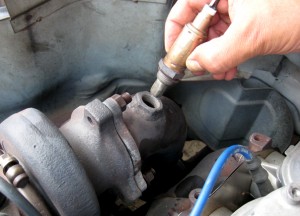 Joining Space Invaders, the personal computer, and perhaps Sputnik in the pantheon of modern technological achievements is the oxygen sensor. Most every modern fuel injected automobile has one or more of these sentinels threaded into its exhaust pipe. Elements inside the oxygen sensor tip measure the amount of oxygen gas in the exhaust, and convert the ratio into a signal that makes sense to the engine computer. The computer uses this signal, along with input from other sensors, to feed the right amount of fuel into the air entering the engine. If all parts are working correctly the fuel, air, and spark balancing act succeeds in ideal combustion! If the oxygen sensor goes haywire, the engine computer can add too much or not enough fuel. Poor fuel economy, lousy emissions, or both can be the result of a spent or malfunctioning oxygen sensor. The good news is an oxygen, or O2 sensor is about as easy to remove and replace as a spark plug.
Joining Space Invaders, the personal computer, and perhaps Sputnik in the pantheon of modern technological achievements is the oxygen sensor. Most every modern fuel injected automobile has one or more of these sentinels threaded into its exhaust pipe. Elements inside the oxygen sensor tip measure the amount of oxygen gas in the exhaust, and convert the ratio into a signal that makes sense to the engine computer. The computer uses this signal, along with input from other sensors, to feed the right amount of fuel into the air entering the engine. If all parts are working correctly the fuel, air, and spark balancing act succeeds in ideal combustion! If the oxygen sensor goes haywire, the engine computer can add too much or not enough fuel. Poor fuel economy, lousy emissions, or both can be the result of a spent or malfunctioning oxygen sensor. The good news is an oxygen, or O2 sensor is about as easy to remove and replace as a spark plug.
Loop the Loop
The engine computer already has built in data to deal with engine start and warm up along with running around. This mode is known as open loop. The stored information is similar to the read only memory that tells the Space Invaders always begin their video attack with plenty of aliens – and always find more where they came from. Once the engine and oxygen sensor reach operating temperature the system moves into a closed loop. The oxygen sensor makes like Sputnik in the exhaust pipe, and broadcasts a signal as voltage to the engine computer. In the ideal world of complete combustion, the fuel to air ratio hovers at the point where the most complete burn of the fuel added to the air is reached. This 14.7 parts air to one part fuel ratio is known as stoichiometric. If an oxygen sensor goes wonky it can send the wrong signal. Too much fuel and the engine runs rich. Too little fuel and the engine runs lean.
Oxygen Sensor Check Remove and Replace
Useful Things:
- Engine Code Reader or Multimeter
- Hand Tools
- Oxygen Sensor Socket
Remove and Replace
Fuel economy can suffer if an engine is running too rich. An engine that is running lean can run down on performance and experience internal damage. A foul running engine can also ruin the catalytic converter, a far more expensive part than an oxygen sensor. The same engine computer that makes things run right also knows when things have gone wrong. A malfunctioning O2 sensor is one of numerous faults that can trip the Check Engine Light or throw a malfunction code. While every vehicle made after 1996 adheres to a standard known as On Board Diagnostics II (OBD-II), cars and trucks made before 1996 are not so standardized. Adding to the confusion is that some automobiles can have four or more (!) O2 sensors. Removing and replacing a bad oxygen sensor is a matter of lefty loosey and righty tighty. Removing and replacing a good oxygen sensor is not going to solve any problems. A code reader or voltage multimeter can help sniff out the bad ones.





Replacing an O2 sensor really is as easy as replacing a spark plug, albeit a spark plug that’s been threaded into cast iron and subjected to road grime and intermittent moisture for a number of years, likely resulting in bloody knuckles and a generous sprinkling of swear words.
I have seldom been so well loved by the universe as to have an O2 sensor come without a fight. Cheater bars and liberal amounts of PB B’laster are my preferred tools for this job.
Here’s something I’ve been wondering about O2 sensors and still haven’t found a decent answer: I replaced my 4-1 exhaust manifold with a 4-2-1 new one, and the sensor which used to sit right before the cat now stays closer to the engine block, attached directly to the 3rd cylinder exhaust pipe (before it joins with the other cylinders’ exhausts). Could having only one cylinder covered by the sensor impact negatively on the car’s performance/gas mileage/emissions?
Hey Paulo. I’ll say yes. If the O2 sensor is only sniffing number three exhaust then it’s probably a good idea to relocate it downstream so it can sniff out the balance of all four cylinders.
Is this the same Starion that used to be featured on: “And you will know us by the trail of parts” articles?
You are correct! It is still my Starion. Those shots were from a recent O2 swap though.